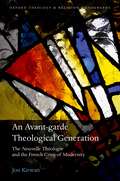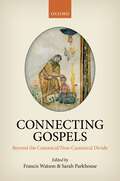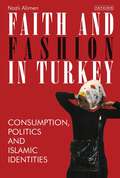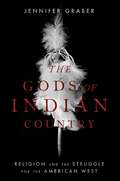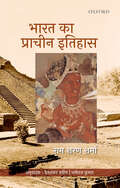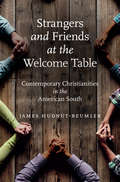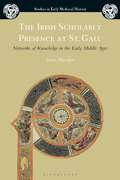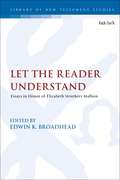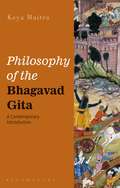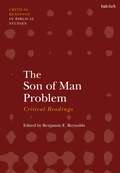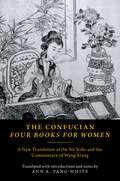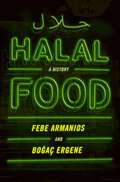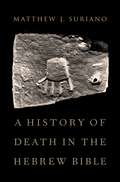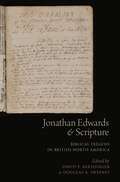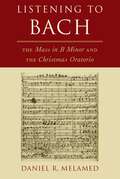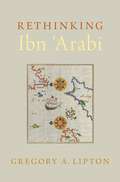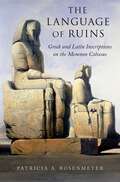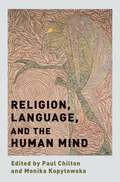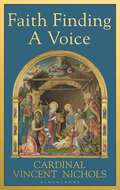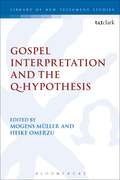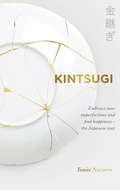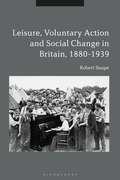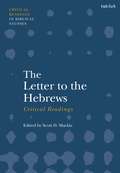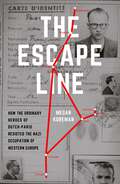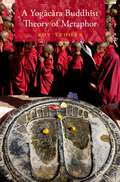- Table View
- List View
An Avant-garde Theological Generation: The Nouvelle Théologie and the French Crisis of Modernity (Oxford Theology and Religion Monographs)
by Jon KirwanAn Avant-garde Theological Generation examines the Fourvière Jesuits and Le Saulchoir Dominicans, theologians and philosophers who comprised the influential reform movement the nouvelle théologie. Led by Henri de Lubac, Jean Daniélou, Yves Congar, and Marie-Dominique Chenu, the movement flourished from the 1930s until its suppression in 1950. It aims to remedy certain historical deficiencies by constructing a history both sensitive to the wider intellectual, political, economic, and cultural milieu of the French interwar crisis, and that establishes continuity with the Modernist crisis and the First World War. Chapter One examines the modern French avant-garde generations that have shaped intellectual and political thought in France, providing context for a historical narrative of the nouvelle théologie. Chapters Two and Three examine the influential older generations that flourished from 1893 to 1914, such as the Dreyfus generation, the generation of Catholic Modernists, and two generations of older Jesuits and Dominicans, which were instrumental in the Fourvière Jesuits' development. Chapter Four explores the influence of the First World War and the years of the 1920s, during which the Jesuits and Dominicans were in religious and intellectual formation, relying heavily on unpublished letters and documents from the Jesuits archives in Paris (Vanves). Chapter Five analyses the crises of the interwar period and the emergence of the wider generation of 1930—to which the nouveaux théologiens belonged—and its intellectual thirst for revolution. Chapter Six examines the emergence of the ^ ressourcement thinkers during the tumultuous years of the 1930s. The decade of the 1940s, explored in Chapter Seven, saw the rise to prominence of the members of the generation of 1930, who, thanks to their participation in the resistance, emerged from the Second World War, with significant influence on the postwar French intellectual milieu. Finally, the monograph concludes in Chapter Eight with an examination of the triumph of French Left Catholicism and the nouvelle théologie during the 1960s at the Second Vatican Council.
Connecting Gospels: Beyond the Canonical/Non-Canonical Divide
By the late second century, early Christian gospels had been divided into two groups by a canonical boundary that assigned normative status to four of them while consigning their competitors to the margins. Connecting Gospels: Beyond the Canonical/Non-canonical Divide finds new ways to reconnect these divided texts. Starting from the assumption that, in spite of their differences, all early gospels express a common belief in the absolute significance of Jesus and his earthly career, this authoritative collection makes their interconnectedness fruitful for interpretation. The contributors have each selected a theme or topic and trace it across two or more gospels on either side of the canonical boundary, and the resulting convergences and divergences shed light not least on the canonical texts themselves as they are read from new and unfamiliar vantage points. This volume demonstrates that early gospel literature can be regarded as a single field of study, in contrast to the overwhelming predominance of the canonical four characteristic of traditional gospels scholarship.
Faith and Fashion in Turkey: Consumption, Politics and Islamic Identities
by Nazli AlimenTurkey has witnessed remarkable sociocultural change under the regime of Recep Tayyip Erdogan and his Justice and Development Party (AKP), particularly regarding its religious communities. As individuals with pious identities have increasingly gained access to state power and accumulated economic influence, so religious appearances and practices have become more visible in Turkey's `secular' public spaces. More than this, consumption practices have changed and new Islamic and Islamist identities have emerged. This book investigates three of the most widespread faith-inspired communities in Turkey: the Gulen, Suleymanli and the Menzil. Nazli Alimen compares these communities, looking at their diverse interpretations of Islamic rules related to the body and dress, and how these different groups compete for power and control in Turkey. In tracing what motivates consumption practices, the book adds to the growing interest in the commercial aspects of modest and Islamic fashion. It also highlights the importance of clothing and bodily rituals (such as veiling, grooming and food choices) for the formation of community identities. Based on ethnographic research, Alimen analyses the relationship between the marketplace and religion, and shows how different communities interact with each other and state institutions. Of particular note are the varied expressions of Islamic masculinities and femininities at play. Appealing to a cross-disciplinary readership, the book will be relevant for scholars within Turkish Studies, Gender Studies, Islamic Studies, Fashion, Consumption Studies, Sociology of Religion and Middle Eastern Studies.
The Gods of Indian Country: Religion and the Struggle for the American West
by Jennifer GraberDuring the nineteenth century, white Americans sought the cultural transformation and physical displacement of Native people. Though this process was certainly a clash of rival economic systems and racial ideologies, it was also a profound spiritual struggle. The fight over Indian Country sparked religious crises among both Natives and Americans. In The Gods of Indian Country, Jennifer Graber tells the story of the Kiowa Indians during Anglo-Americans' hundred-year effort to seize their homeland. Like Native people across the American West, Kiowas had known struggle and dislocation before. But the forces bearing down on them-soldiers, missionaries, and government officials-were unrelenting. With pressure mounting, Kiowas adapted their ritual practices in the hope that they could use sacred power to save their lands and community. Against the Kiowas stood Protestant and Catholic leaders, missionaries, and reformers who hoped to remake Indian Country. These activists saw themselves as the Indians' friends, teachers, and protectors. They also asserted the primacy of white Christian civilization and the need to transform the spiritual and material lives of Native people. When Kiowas and other Native people resisted their designs, these Christians supported policies that broke treaties and appropriated Indian lands. They argued that the gifts bestowed by Christianity and civilization outweighed the pains that accompanied the denial of freedoms, the destruction of communities, and the theft of resources. In order to secure Indian Country and control indigenous populations, Christian activists sanctified the economic and racial hierarchies of their day. The Gods of Indian Country tells a complex, fascinating-and ultimately heartbreaking-tale of the struggle for the American West.
Bharat ka Prachin Itihas
by Ram Sharan SharmaBeginning with a discussion on frameworks of writing history, the volume sheds light on the origins and growth of civilizations, empires, and religions. It covers the geographical, ecological, and linguistic backgrounds, and looks at specific cultures of the Neolithic, Chalcolithic, and Vedic periods, as well as the Harappan civilization. The author discussed the rise of Jainism and Buddhism, Magadha, and the beginning of territorial states. The period of Mauryas, Central Asian countries, Satavahanas, Guptas, and Harshvardhana are also analysed. He highlights important phenomena such as the varna system, urbanization, commerce and trade, developments in science and philosophy, and cultural legacy. He also examines the process of transition from ancient to medieval India and addresses topical issues such as the origin of the Aryan culture. This engaging and lucid text, by one of the best-known scholars of ancient India, will be indispensable for students and teachers of ancient Indian history. This book is the Hindi translation of the English edition.
Strangers and Friends at the Welcome Table: Contemporary Christianities in the American South
by James Hudnut-BeumlerIn this fresh and fascinating chronicle of Christianity in the contemporary South, historian and minister James Hudnut-Beumler draws on extensive interviews and his own personal journeys throughout the region over the past decade to present a comprehensive portrait of the South's long-dominant religion. Hudnut-Beumler traveled to both rural and urban communities, listening to the faithful talk about their lives and beliefs. What he heard pushes hard against prevailing notions of southern Christianity as an evangelical Protestant monolith so predominant as to be unremarkable. True, outside of a few spots, no non-Christian group forms more than six-tenths of one percent of a state's population in what Hudnut-Beumler calls the Now South. Drilling deeper, however, he discovers an unexpected, blossoming diversity in theology, practice, and outlook among southern Christians. He finds, alongside traditional Baptists, black and white, growing numbers of Christians exemplifying changes that no one could have predicted even just forty years ago, from congregations of LGBT-supportive evangelicals and Spanish-language church services to a Christian homeschooling movement so robust in some places that it may rival public education in terms of acceptance. He also finds sharp struggles and political divisions among those trying to reconcile such Christian values as morality and forgiveness—the aftermath of the mass shooting at Charleston's Emanuel A.M.E. Church in 2015 forming just one example. This book makes clear that understanding the twenty-first-century South means recognizing many kinds of southern Christianities.
The Irish Scholarly Presence at St. Gall: Networks of Knowledge in the Early Middle Ages (Studies in Early Medieval History)
by Sven MeederThe Carolingian period represented a Golden Age for the abbey of St Gall, an Alpine monastery in modern-day Switzerland. Its bloom of intellectual activity resulted in an impressive number of scholarly texts being copied into often beautifully written manuscripts, many of which survive in the abbey's library to this day. Among these books are several of Irish origin, while others contain works of learning originally written in Ireland. This study explores the practicalities of the spread of this Irish scholarship to St Gall and the reception it received once there. In doing so, this book for the first time investigates a part of the network of knowledge that fed this important Carolingian centre of learning with scholarship.By focusing on scholarly works from Ireland, this study also sheds light on the contribution of the Irish to the Carolingian revival of learning. Historians have often assumed a special relationship between Ireland and the abbey of St Gall, which was built on the grave of the Irish saint Gallus. This book scrutinises this notion of a special connection. The result is a new viewpoint on the spread and reception of Irish learning in the Carolingian period.
Let the Reader Understand: Essays in Honor of Elizabeth Struthers Malbon (The Library of New Testament Studies)
by Edwin K. BroadheadThis book honors the extraordinary contribution of Elizabeth Struthers Malbon to biblical studies. In the opening chapter, Werner Kelber places Malbon's work within the larger context of critical reflection, from antiquity to the modern era, on the role and function of discourse. Kelber locates Malbon's approach squarely within the framework of modernity and concludes that her “supremely creative achievement has been the employment of modern, narrative critical tools with a view toward uncovering the fecundity of the gospel of Mark.”Drawing from and conversing with Professor Malbon's extensive publications, each of the five sections engages a theme from her works, focusing particularly on the Gospel of Mark. This tribute includes meaning as narrative, issues in methodology, studies in characterization, narrative readings of specific texts, and aesthetic and political readings. Contributors include: Werner H. Kelber; R. Alan Culpepper; Kelly R. Iverson; Mikeal C. Parsons; David Barr; David J.A. Clines; Robert C. Tannehill; J. Cheryl Exum; Heidi Hornik and Richard Walsh.
Philosophy of the Bhagavad Gita: A Contemporary Introduction
by Keya MaitraPhilosophy of The Bhagavad Gita: A Contemporary Introduction presents a complete philosophical guide and new translation of the most celebrated text of Hinduism. While usually treated as mystical and religious poetry, this new translation focuses on the philosophy underpinning the story of a battle between two sets of cousins of the Aryan clan. Designed for use in the classroom, this lively and readable translation: - Situates the text in its philosophical and cultural contexts - Features summaries and chapter analyses and questions at the opening and end of each of the eighteen chapters encouraging further study - Highlights points of comparison and overlap between Indian and Western philosophical concepts and themes such as just war, care ethics, integrity and authenticity - Includes a glossary allowing the reader to determine the meaning of central concepts Written with clarity and without presupposing any prior knowledge of Hinduism, Philosophy of the Bhagavad Gita: A Contemporary Introduction reveals the importance and value of reading the Gita philosophically.
The Son of Man Problem: Critical Readings (T&T Clark Critical Readings in Biblical Studies)
by Benjamin E. ReynoldsThe Son of Man sayings are some of the most contested sayings in the Gospels. They preserve a phrase employed by Jesus to refer to himself, yet the meaning of the saying in its various contexts has been hotly debated for centuries. Some identify allusions to other literature in the bible, including the book of Daniel. Others see it as simply being a strange rendering in Greek of an Aramaic phrase that was relatively commonplace. The history of research on these sayings is here presented by Benjamin E. Reynolds in a volume of critical readings, which provides access to over 50 years of scholarly research. These essays and articles include the most often cited articles that address the various aspects of the Son of Man debate. In addition to these most well-known pieces Reynolds includes carefully selected additional essays that allow readers to trace different developments in the debate and to provide an entry into the waters of 'the Son of Man Problem' and the numerous solutions that have been offered. Each section features an introduction and a section of annotated further readings.
The Confucian Four Books for Women: A New Translation of the Nü Sishu and the Commentary of Wang Xiang
by Ann A. Pang-WhiteThis volume presents the first English translation of the Confucian classics, Four Books for Women, with extensive commentary by the compiler, Wang Xiang, and introductions and annotations by translator Ann A. Pang-White. Written by women for women's education, the Confucian Four Books for Women spanned the 1st to the 16th centuries, and encompass Ban Zhao's Lessons for Women, Song Ruoxin's and Song Ruozhao's Analects for Women, Empress Renxiaowen's Teachings for the Inner Court, and Madame Liu's (Chaste Widow Wang's) Short Records of Models for Women. A female counterpart to the famous Sishu (Four Books) compiled by Zhu Xi, Wang Xiang's Nü sishu provides an invaluable look at the long-standing history and evolution of Chinese women's writing, education, identity, and philosophical discourse, along with their struggles and triumphs, across the millennia and numerous Chinese dynasties. Pang-White's new translation brings the authors of the Four Books for Women to life as real, living people, and illustrates why they wrote and how their work empowered women.
Halal Food: A History
by Febe Armanios Bogac ErgeneFood trucks announcing "halal" proliferate in many urban areas but how many non-Muslims know what this means, other than cheap lunch? Here Middle Eastern historians Febe Armanios and Bogac Ergene provide an accessible introduction to halal (permissible) food in the Islamic tradition, exploring what halal food means to Muslims and how its legal and cultural interpretations have changed in different geographies up to the present day. Historically, Muslims used food to define their identities in relation to co-believers and non-Muslims. Food taboos are rooted in the Quran and prophetic customs, as well as writings from various periods and geographical settings. As in Judaism and among certain Christian sects, Islamic food traditions make distinctions between clean and impure, and dietary choices and food preparation reflect how believers think about broader issues. Traditionally, most halal interpretations focused on animal slaughter and the consumption of intoxicants. Muslims today, however, must also contend with an array of manufactured food products--yogurts, chocolates, cheeses, candies, and sodas--filled with unknown additives and fillers. To help consumers navigate the new halal marketplace, certifying agencies, government and non-government bodies, and global businesses vie to meet increased demands for food piety. At the same time, blogs, cookbooks, restaurants, and social media apps have proliferated, while animal rights and eco-conscious activists seek to recover halal's more wholesome and ethical inclinations. Covering practices from the Middle East and North Africa to South Asia, Europe, and North America, this timely book is for anyone curious about the history of halal food and its place in the modern world.
A History of Death in the Hebrew Bible
by Matthew SurianoPostmortem existence in the Hebrew Bible/Old Testament was rooted in mortuary practices and conceptualized through the embodiment of the dead. But this idea of the afterlife was not hopeless or fatalistic, consigned to the dreariness of the tomb. The dead were cherished and remembered, their bones were cared for, and their names lived on as ancestors. This book examines the concept of the afterlife in the Hebrew Bible by studying the treatment of the dead, as revealed both in biblical literature and in the material remains of the southern Levant. The mortuary culture of Judah during the Iron Age is the starting point for this study. The practice of collective burial inside a Judahite rock-cut bench tomb is compared to biblical traditions of family tombs and joining one's ancestors in death. This archaeological analysis, which also incorporates funerary inscriptions, will shed important insight into concepts found in biblical literature such as the construction of the soul in death, the nature of corpse impurity, and the idea of Sheol. In Judah and the Hebrew Bible, death was a transition that was managed through the ritual actions of the living. The connections that were forged through such actions, such as ancestor veneration, were socially meaningful for the living and insured a measure of immortality for the dead.
Jonathan Edwards and Scripture: Biblical Exegesis in British North America
For too long, scholars have published new research on Edwards without paying due attention to the work he took most seriously: biblical exegesis. Edwards is recognized as an innovative theologian who wielded tremendous influence on revivalism, evangelicalism, and New England theology. What is often missed is how much time he devoted to studying and understanding the Bible. He kept voluminous notebooks on Scripture and died with unrealized plans for major treatises on the Bible. More and more experts now recognize the importance of this aspect of his life; this book brings together the insights of leading Edwards scholars on this topic. The essays in Jonathan Edwards and Scripture set Edwards' engagement with Scripture in the context of seventeenth-century Protestant exegesis and eighteenth-century colonial interpretation. They provide case studies of Edwards' exegesis in varying genres of the Bible and probe his use of Scripture to develop theology. The authors also set his biblical interpretation in perspective by comparing it with that of other exegetes. This book advances our understanding of the nature and significance of Edwards' work with Scripture and opens new lines of inquiry for students of early modern Western history.
Listening to Bach: The Mass in B Minor and the Christmas Oratorio
by Daniel R. MelamedOf all the things we can know about J. S. Bach's Mass in B Minor and Christmas Oratorio, the most profound come from things we can hear. Listening to Bach explores musical style as it was understood in the early eighteenth century. It encourages ways of listening that take eighteenth-century musical sensibilities into account and that recognize our place as inheritors of a long tradition of performance and interpretation. Daniel R. Melamed shows how to recognize old and new styles in sacred music of Bach's time, and how movements in these styles are constructed. This opens the possibility of listening to the Mass in B Minor as Bach's demonstration of the possibilities of contrasting, combining, and reconciling old and new styles. It also shows how to listen for elements that would have been heard as most significant in the early eighteenth century, including markers of sleep arias, love duets, secular choral arias, and other movement types. This offers a musical starting point for listening for the ways Bach put these types to use in the Mass in B Minor and the Christmas Oratorio. The book also offers ways to listen to and think about works created by parody, the re-use of music for new words and a new purpose, like almost all of the Mass in B Minor and Christmas Oratorio. And it shows that modern performances of these works are stamped with audible consequences of our place in the twenty-first century. The ideological choices we make in performing the Mass and Oratorio, part of the legacy of their performance and interpretation, affect the way the work is understood and heard today. All these topics are illustrated with copious audio examples on a companion Web site, offering new ways of listening to some of Bach's greatest music.
Rethinking Ibn 'Arabi
by Gregory A. LiptonThe thirteenth century mystic Ibn `Arabi was the foremost Sufi theorist of the premodern era. For more than a century, Western scholars and esotericists have heralded his universalism, arguing that he saw all contemporaneous religions as equally valid. In Rethinking Ibn `Arabi, Gregory Lipton calls this image into question and throws into relief how Ibn `Arabi's discourse is inseparably intertwined with the absolutist vision of his own religious milieu--that is, the triumphant claim that Islam fulfilled, superseded, and therefore abrogated all previous revealed religions. Lipton juxtaposes Ibn `Arabi's absolutist conception with the later reception of his ideas, exploring how they have been read, appropriated, and universalized within the reigning interpretive field of Perennial Philosophy in the study of Sufism. The contours that surface through this comparative analysis trace the discursive practices that inform Ibn `Arabi's Western reception back to the eighteenth and nineteenth century study of "authentic" religion, where European ethno-racial superiority was wielded against the Semitic Other-both Jewish and Muslim. Lipton argues that supersessionist models of exclusivism are buried under contemporary Western constructions of religious authenticity in ways that ironically mirror Ibn `Arabi's medieval absolutism.
The Language of Ruins: Greek and Latin Inscriptions on the Memnon Colossus
by Patricia A. RosenmeyerA colossal statue, originally built to honor an ancient pharaoh, still stands today in Egyptian Thebes, with more than a hundred Greek and Latin inscriptions covering its lower surfaces. Partially damaged by an earthquake, and later re-identified as the Homeric hero Memnon, it was believed to "speak" regularly at daybreak. By the middle of the first century CE, tourists flocked to the colossus of Memnon to hear the miraculous sound, and left behind their marks of devotion (proskynemata): brief acknowledgments of having heard Memnon's cry; longer lists by Roman administrators; and more elaborate elegiac verses by both amateur and professional poets. The inscribed names left behind reveal the presence of emperors and soldiers, provincial governors and businessmen, elite women and military wives, and families with children. While recent studies of imperial literature acknowledge the colossus, few address the inscriptions themselves. This book is the first critical assessment of all the inscriptions considered in their social, cultural, and historical context. The Memnon colossus functioned as a powerful site of engagement with the Greek past, and appealed to a broad segment of society. The inscriptions shed light on contemporary attitudes toward sacred tourism, the role of Egypt in the Greco-Roman imagination, and the cultural legacy of Homeric epic. Memnon is a ghost from the Homeric past anchored in the Egyptian present, and visitors yearned for a "close encounter" that would connect them with that distant past. The inscriptions thus idealize Greece by echoing archaic literature in their verses at the same time as they reflect their own historical horizon. These and other subjects are expertly explored in the book, including a fascinating chapter on the colossus's post-classical life when the statue finds new worshippers among Romantic artists and poets in nineteenth-century Europe.
Religion, Language, and the Human Mind
What is religion? How does it work? Many natural abilities of the human mind are involved, and crucial among them is the ability to use language. This volume brings together research from linguistics, cognitive science and neuroscience, as well as from religious studies, to understand the phenomena of religion as a distinctly human enterprise. The book is divided into three parts, each part preceded by a full introductory chapter by the editors that discusses modern scientific approaches to religion and the application of modern linguistics, particularly cognitive linguistics and pragmatics. Part I surveys the development of modern studies of religious language and the diverse disciplinary strands that have emerged. Beginning with descriptive approaches to religious language and the problem of describing religious concepts across languages, chapters introduce the turn to cognition in linguistics and also in theology, and explore the brain's contrasting capacities, in particular its capacity for language and metaphor. Part II continues the discussion of metaphor - the natural ability by which humans draw on basic knowledge of the world in order to explore abstractions and intangibles. Specialists in particular religions apply conceptual metaphor theory in various ways, covering several major religious traditions-Buddhism, Christianity, Hinduism, Islam and Judaism. Part III seeks to open up new horizons for cognitive-linguistic research on religion, looking beyond written texts to the ways in which language is integrated with other modalities, including ritual, religious art, and religious electronic media. Chapters in Part III introduce readers to a range of technical instruments that have been developed within cognitive linguistics and discourse analysis in recent years. What unfolds ultimately is the idea that the embodied cognition of humans is the basis not only of their languages, but also of their religions.
Faith Finding a Voice
by Cardinal Vincent NicholsIn Faith Finding a Voice Cardinal Vincent Nichols invites us to join him in an exploration of the presence of God in our lives. How might we attune our ears to listen with greater attention to the voice of God, through Scripture, the teachings of the Church, divine worship and the exercise of Caritas? How might the gift of faith be realised in our lives in order that an authentic voice might be heard through our words and actions?The reader is encouraged to reflect upon the mystery of the Triune God revealed to humanity and seen uniquely in Jesus Christ. Drawing primarily upon the altarpiece The Nativity with Saints by Pietro Orioli, Cardinal Vincent shows how, by following the way and ministry of Jesus, we are drawn into union with the divine, now and for all eternity.Through this vision the Cardinal advocates the necessity of theological and religious literacy for the common good of society. This engagement encourages us to nourish the seeds of hope and to strive to build a more peaceful world through inter-faith dialogue.Such dialogue is enhanced, the Cardinal believes, through the baptised faithful understanding their role as 'missionary disciples' (Pope Francis, Evangelii Gaudium, 120). The ministries of the Church are portrayed as an interlocking framework in which the unity of the faithful may glorify God and serve humanity through the voice of evangelization.
Gospel Interpretation and the Q-Hypothesis (The Library of New Testament Studies)
by Mogens Müller Heike OmerzuThe Q-Hypothesis has functioned as a mainstay of study of the synoptic gospels for many years. Increasingly it comes under fire. In this volume leading proponents of Q, as well as of the case against Q, offer the latest arguments based on the latest research into this literary conundrum. The contributors to the volume include John Kloppenborg, Christopher Tuckett, Clare Rothschild, Mark Goodacre, and Francis Watson. The Q-Hypothesis is examined in depth and the discussion moves back and forth over Q's strengths and weaknesses. As such the volume sheds light on how the gospels were composed, and how we can view them in their final literary forms.
Kintsugi: Embrace your imperfections and find happiness - the Japanese way
by Tomás NavarroDiscover how to embrace the imperfect with Kintsugi. Apply this ancient principle to your life and you will learn how to repair yourself, rebuild your life and love your flaws.Japanese Kintsugi masters delicately patch up broken ceramics with gold adhesive, leaving the restoration clearly visible to others. Psychologist Tomás Navarro believes that we should approach our lives with the same philosophy. Everyone faces suffering, but it is the way in which we overcome our troubles, and heal our emotional wounds, that is key. We shouldn't conceal our repairs, they are proof of our strength.Navarro presents real solutions to genuine problems that he has seen in his professional practice. His anecdotes demonstrate that it is possible to transform adversity or setbacks into a strength. His psychological understanding and perspective will leave you feeling courageous and prepared, should you experience misfortune, be it heartbreak, a job loss or bereavement.Often practised alongside Ikigai (or the art of finding one's life purpose), Kintsugi shows you how happiness can be found again, often against all odds. A painful experience can in fact make you a more determined individual, ready to face the world with optimism.'Kintsugi, which translates as "golden joinery", is the latest lifestyle trend promising to transform our lives.' - The Telegraph
Leisure, Voluntary Action and Social Change in Britain, 1880-1939
by Robert SnapeIn the final decades of the nineteenth century modernizing interpretations of leisure became of interest to social policy makers and cultural critics, producing a discourse of leisure and voluntarism that flourished until the Second World War. The free time of British citizens was increasingly seen as a sphere of social citizenship and community-building. Through major social thinkers, including William Morris, Thomas Hill Green, Bernard Bosanquet and John Hobson, leisure and voluntarism were theorized in terms of the good society. In post-First World War social reconstruction these writers remained influential as leisure became a field of social service, directed towards a new society and working through voluntary association in civic societies, settlements, new estate community-centres, village halls and church-based communities. This volume documents the parallel cultural shift from charitable philanthropy to social service and from rational recreation to leisure, teasing out intellectual influences which included social idealism, liberalism and socialism. Leisure, Robert Snape claims, has been a central and under-recognized organizing force in British communities. Leisure, Voluntary Action and Social Change in Britain, 1880-1939 marks a much needed addition to the historiography of leisure and an antidote to the widely misunderstood implications of leisure to social policy today.
The Letter to the Hebrews: Critical Readings (T&T Clark Critical Readings in Biblical Studies)
by Scott D. MackieThe Letter to the Hebrews is a key text in the New Testament canon. It has recently received a great deal of attention, prompting a resurgence of scholarly works, and a need to re-engage with some of the foundational works of scholarship on the text. The history of research on Hebrews is presented in this volume of critical readings, edited by Scott D. Mackie. The volume is organized thematically, addressing the following sub-areas: theology, Christology and pneumatology; eschatology; authorship and audience; structure and Greco-Roman influences; the relationship with contemporaneous Judaism, and soteriology. Each section is prefaced by an introduction and summary of the particular theme in Hebrews. At the end of each section is an annotated bibliography to point researchers towards further readings in and engagements with these key themes.
The Escape Line: How the Ordinary Heroes of Dutch-Paris Resisted the Nazi Occupation of Western Europe
by Megan KoremanOf all the resistance organizations that operated during the war, about which much has been written, one stands out for its transnational character, the diversity of the tasks its members took on, and the fact that, unlike many of the known evasion lines, it was not directed by Allied officers, but rather by group of ordinary citizens. Between 1942 and 1945, they formed a network to smuggle Dutch Jews and others targeted by the Nazis south into France, via Paris, and then to Switzerland. This network became known as the Dutch-Paris Escape Line, eventually growing to include 300 people and expanding its reach into Spain. Led by Jean Weidner, a Dutchman living in France, many lacked any experience in clandestine operations or military tactics, and yet they became one of the most effective resistance groups of the Second World War. Dutch-Paris largely improvised its operations-scrounging for food on the black market, forging documents, and raising cash. Hunted relentlessly by the Nazis, some were even captured and tortured. In addition to Jews, those it helped escape the clutches of the Nazis included resistance fighters, political foes, Allied airmen, and young men looking to get to London to enlist. As the need grew more desperate, so did the bravery of those who rose to meet it. Using recently declassified archives, The Escape Line tells the story of the Dutch-Paris and the thousands of people it saved during World War II. Author Megan Koreman, who was given exclusive access to many of the archives, is herself the daughter of Dutch parents who were part of the resistance.
A Yog=ac=ara Buddhist Theory of Metaphor
by Roy TzoharBuddhist philosophy is fundamentally ambivalent toward language. Language is paradoxically seen as both obstructive and necessary for liberation. In this book, Roy Tzohar delves into the ingenious response to this tension from the Yogacara school of Indian Buddhism: that all language-use is metaphorical. Exploring the profound implications of this claim, Tzohar makes the case for viewing the Yogacara account as a full-fledged theory of meaning, one that is not merely linguistic, but also applicable both in the world as well as in texts. Despite the overwhelming visibility of figurative language in Buddhist philosophical texts, this is the first sustained and systematic attempt to present an indigenous Buddhist theory of metaphor. By grounding the Yogacara pan-metaphorical claim in a broader intellectual context, of both Buddhist and non-Buddhist schools, the book uncovers an intense philosophical conversation about metaphor and language that reaches across sectarian lines. Tzohar's analysis radically reframes the Yogacara controversy with the Madhyamaka school of philosophy, sheds light on the Yogacara application of particular metaphors, and explicates the school's unique understanding of experience.
